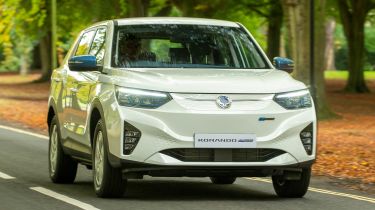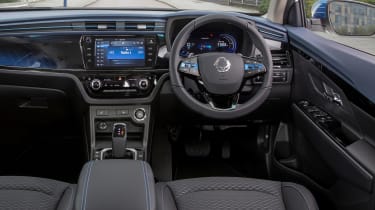New SsangYong Korando e-Motion 2022 review
The Korando e-Motion is the first all-electric from SsangYong and arrives with a promised range of 211 miles
Verdict
The Korando e-Motion is another curio from the SsangYong stable, but it’s not without appeal. Its average driving dynamics and cabin finish could well be outshone by practicality and charging capability matched by few EVs at this price. A generous standard equipment list and a lengthy warranty may well seal the deal.
These are exciting times at SsangYong. After years of struggles, the Korean brand has fresh investment thanks to a takeover by Edison Motors, a local rival – and this means that it could also be nicely positioned as the world moves towards electrification. Three new pure-electric models - likely to all be SUVs - are due by 2025, and ahead of the as-yet-unseen trio, the push has already started, with the Korando e-Motion.
The model name is familiar because the Qashqai-sized Korando has been at the heart of SsangYong’s line-up since the nineties. And you can still buy conventionally powered versions of the car, with a choice of front-wheel drive petrol and diesel versions, and a four-wheel-drive diesel.
In pure-electric form, though, the Korando looks set to be a typical SsangYong in that it has few direct rivals that can match it for price, size or equipment. None of the regular car’s competitors - Qashqai, Peugeot 3008, MG HS, Kia Sportage and Hyundai Tucson - is available as an EV. Of those models that are - the Peugeot 2008, MG ZS, Hyundai’s Kona and Kia’s e-Niro - are either considerably smaller and/or noticeably more expensive.
Used - available now

2023 Land Rover
Range Rover Evoque
18,682 milesAutomaticDiesel2.0L
Cash £33,995
2019 BMW
1 Series
48,573 milesAutomaticPetrol1.5L
Cash £13,987
2017 Ford
Fiesta
38,600 milesManualPetrol1.2L
Cash £6,100
2016 Tesla
Model S
78,000 milesAutomaticElectric
Cash £18,999There’s a single technical spec of Korando e-Motion, with three trim levels. All cars get a decent-sized 61.5kWh battery (55.3kWh usable), offering a WLTP range of 211 miles. There’s a single 188bhp motor at the front, delivering a 0-62mph time of nine seconds, and you get 100kW DC charging as standard too.
The range starts with ELX, which costs £31,995 (or £30,495 after the Plug-in Car Grant is applied) and is generously equipped; you get an eight-inch touchscreen infotainment system with Android and Apple integration, a 12.3-inch digital instrument panel, 17-inch alloy wheels, auto lights and wipers, cruise control, a rear-view camera and dual-zone climate control.
Step up to Ventura, the version we’re driving here, and the equipment list features heated seats and LED headlights - both decent additions, we’d argue - and a larger, higher-definition, 9.2-inch infotainment display (probably worth the extra) which houses a TomTom-based navigation system (easily ignored in favour of Apple or Google). There’s also leather on the steering wheel, luxury carpet mats and rear parking sensors - but this is all accompanied by a hike in price, to £34,995, which takes the Ventura above the PiCG threshold and thereby creates a £4,500 jump in the line-up.
Range-topping Ultimate Korando e-Motions offer a wireless smartphone charger, a heated steering wheel, a heat pump for greater cold-weather efficiency, a powered tailgate, front parking sensors and leather upholstery. The price rises again, of course, to £37,995.
The higher two figures probably sound a little rich for a SsangYong but, as we’ve seen so often with other brands recently, the EV market is such a sporadically occupied arena that the Korando actually looks good value on paper. The WLTP figure is respectable for a £35k electric car; the 100KW charging capability is more generous than many at this price. And the transition to EV hasn’t blunted the Korando’s practicality, either; this is a car that can accommodate four six-footers in comfort, and the 551-litre boot (equipped with a variable-height floor) is a full 100 litres up on the e-Niro (or MG’s ZS EV) and more than 200 clear of the Kona.
On the road, the Korando e-Motion is pretty easy to forget dynamically - which is as much to say that it does little horrendously wrong as it is confirmation that it doesn’t dazzle. The motor has typical instant EV punch, delivering strong 0-30mph performance around town, and the electronic aids do a decent job of minimising torque steer and wheelspin if you’re aggressive with the right-hand pedal.
There’s not much EV whine to accompany harder acceleration, too, and once you’re beyond walking pace, the motor noise is drowned out by road roar from the Nexen tyres. It’s not the quietest EV we’ve experienced, but it’s refined by combustion-engined car standards, and a world away from SsangYong’s diesel motors.
The chassis is happiest at relatively low speeds, where the suspension does a good job of keeping the tall body reasonably tied down over all but the worst road scars. Out of town, things can get a little unruly, as the car struggles to keep its own body movement in check in faster changes of direction, and over rougher surfaces. The steering is accurate and consistent, though, so let’s just say that a patient approach in either the Eco or Normal mode (give the Sport setting a wide berth) will be rewarded with a steady, uneventful drive.
It should be a relatively efficient one too; over a mix of slow suburban and faster country roads, and including a short motorway squirt, our Korando e-Motion reported energy consumption of 3.3 miles per kWh - enough, based on the usable battery capacity, for a real-world range of around 180 miles. Those who are buying their Korando for zero-emissions school runs - and making use of the speed-limited Eco mode, would probably exceed that figure.
Low running costs could well join practicality on the Korando e-Motion’s list of top qualities, then. The cabin is less likely to feature, since its space isn’t quite matched by fit and finish. It’s all functional enough, with sensible switches and rotary controls, and the digital displays are crisp and have slick graphics. It seems well screwed together, too, and SsangYong’s seven-year/90,000-mile warranty demonstrates confidence.
But there’s a bit too much piano-black plastic - the type that tends to scratch easily - and some of the other materials, including those used on the chrome doorhandles and the steering-wheel paddles for controlling the level of brake-energy recuperation, feel pretty cheap in your fingers. It’s here, rather than on space, tech or on-road behaviour, where the Korando e-Motion feels most like a budget offering.
| Model: | SsangYong Korando e-Motion Ventura |
| Price: | £34,995 |
| Engine: | 1x e-motor, 55.3kWh battery (usable) |
| Power/torque: | 188bhp/360Nm |
| Transmission: | Single-speed auto, front-wheel drive |
| 0-62mph: | 9.0 seconds |
| Top speed: | 97mph (est) |
| Range: | 211 miles |
| Max charging: | 100kW DC (20-80% in 33 mins) |
| On sale: | March |











